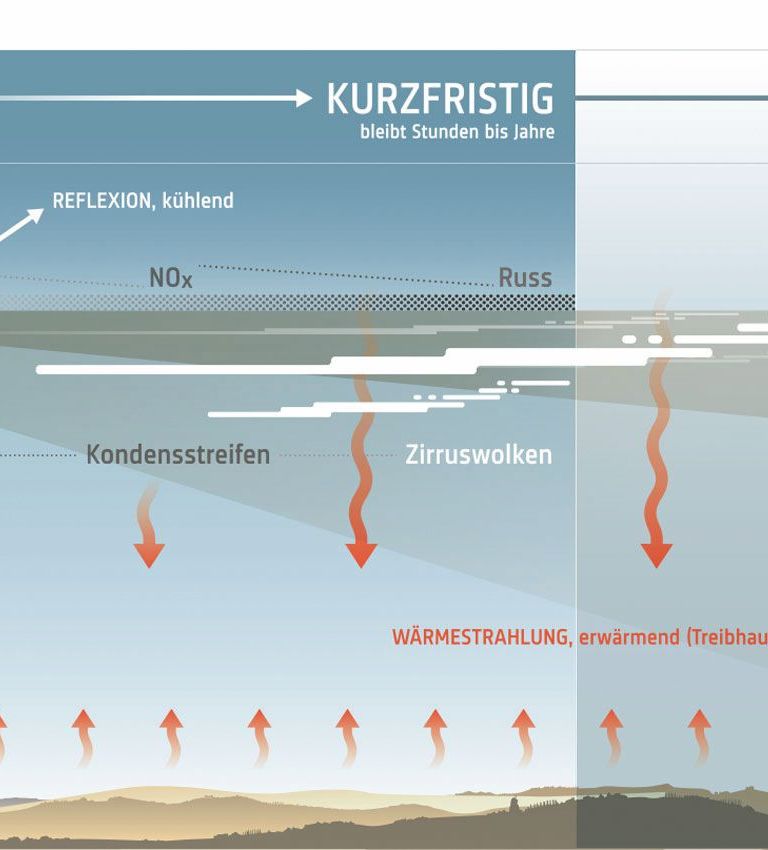The impact of emissions from aviation on the climate
This publication describes how the main emission components of aviation affect the climate. It also discusses how these components are quantified and which comparative values should be used.
Greenhouse gas emissions from global aviation are steadily and sharply increasing and their part in global CO2 emissions is growing. This trend is particularly high in industrialised countries. In addition to CO2, however, aviation also emits other components that have an impact on the climate. These are in particular water vapour, nitrogen oxides, sulphur dioxide and soot. This publication describes how the main emission components of aviation affect the climate. It also discusses how these components are quantified and which comparative values should be used.
This report is an updated version of the Swiss Academies Communications Vol. 15 (9).
Edition / Volume: 2nd Edition, 2021 (online)
Source: Neu U (2021) The impact of emissions from aviation on the climate. Swiss Academies Communications 16 (3).
ProClim Reports & Factsheets
- Schweizer Energiesystem 2050 (Kurzfassung): Wege zu netto null CO2 und Versorgungssicherheit
- Swiss Energy System 2050: Pathways to Net Zero CO2 and Security of Supply
- Climate effect and CO2 equivalent emissions of short-lived substances
- Trendwende Klima und Biodiversität
- Tackling climate change and biodiversity loss jointly
- The impact of emissions from aviation on the climate
- Instrumente für eine wirksame und effiziente Klima- und Energiepolitik
- Chancen und Auswirkungen einer CO2-Lenkungsabgabe auf Treibstoffe
- Instrumente für eine wirksame und effiziente Klima- und Energiepolitik
- CH-Impacts. Klimaszenarien CH2018 und daraus abgeleitete Folgen für die Schweiz – wie weiter?
- Klima- und Energiepolitik
- Reverse emissions or influence solar radiation: Is “geoengineering” worthwhile, feasible and if so, at what price?
- Spotlight on climate in Switzerland
- Brennpunkt Klima Schweiz
- Energiestrategie und Gesundheit: Was bei der Umsetzung der Energiestrategie zu beachten ist
- Gesundheitliche Aspekte der Schweizerischen Energiestrategie 2050
- Switzerland and the Commodities Trade
- IPCC Future - Experiences and recommendations for the development
- Mit Wissenschaft die Politik erreichen
- Anpassung an den Klimawandel in der Schweiz: Forschung, Umsetzung und Monitoring
- Factsheet "Energiepolitik und Klimaschutz mit Luftreinhaltung verbinden"
- A Focus on Fracking (Factsheet)
- Eine Technik im Fokus: Fracking (Langfassung)
- Environmental change and migration in developing countries
- IPCC AR5 WG I Report "The Physical Science Basis"
- ProClim- recommendations for the Future Earth Program
- Klimaziele und Emissionsreduktion
- A climate target for Switzerland - How much ambition can we afford?
- Lösungsansätze im Konfliktfeld zwischen erneuerbaren Energien und Raumnutzung – Kurzfassung
- Lösungsansätze im Konfliktfeld zwischen erneuerbaren Energien und anderen Raumnutzungen - Gesamtbericht
- Zukunft Stromversorgung Schweiz - Langfassung
- Zukunft Stromversorgung Schweiz - Synthese
- How accurate are climate models?
- Arguments from Global Warming Sceptics
- Klimakonferenz Kopenhagen: Die grosse Herausforderung des 2 °C-Klimaziels
- Technischer Klimaschutz: Wo steht die CCS-Technologie?
- Kein Stillstand der globalen Erwärmung
- Wie schnell schmilzt Grönlands Eis?
- Climate change is a fact - and now?
- Heat summer 2003
- Climate change is a fact – also in Switzerland
- Nationales Klimabeobachtungssystem
- Extreme Events and Climate Change
- Denk-Schrift Energie
- Biodiversity and climate
- Mit Geoengineering gegen die Klimaerwärmung: Dilemma zwischen Möglichkeiten und Risiken
- Climate Change and Switzerland 2050
- Rapport du GIEC: Le climat change
- IPCC Klimaänderung 2007: Zusammenfassungen für politische Entscheidungsträger
- Re-thinking energy
- Energy resources: figures and facts
- Sources d'énergie: chiffres et faits
- Energieressourcen: Zahlen und Fakten
- Verstärkt die globale Erwärmung Wirbelstürme?
- Ist Klimaschutz für die Wirtschaft interessant?
- Widersprüche zwischen Satellitendaten und bodennahen Temperaturmessungen sind weitgehend ausgeräumt
- Handel fürs Klima
- Bestimmt die kosmische Strahlung das Klima?
- Globale Erwärmung als Auslöser einer abrupten Klimaänderung
- Schweizer Forschende fordern vom Bundesrat eine rasche Umsetzung des CO2-Gesetzes
- War es früher wärmer als heute?
- Water power and climate change – vision for 2030
- Erste Spuren der Klimaänderung in der Pflanzen- und Tierwelt
- Wintertourismus: Können die Folgen der Klimaerwärmung mit Investitionen kompensiert werden?
- Aerosole - Ein Fragezeichen hinter der Zukunft des Klimas
- Warum harzt das Kyoto-Protokoll?
- Nachhaltige Elektrizitätsversorgung
- Ozon: Zuviel zum Atmen, zuviel für das Klima, zuwenig für den Sonnenschutz
- Klimaerwärmung: Schuldspruch im Indizienprozess gefällt
- Kann das Polareis dem wachsenden Treibhauseffekt standhalten?
- Secondary Benefits of Greenhouse Gas Reduction (German/French/English)
- Sind Dürren für die Schweiz eine zukünftige Bedrohung?
- Wird das Klima extremer?
- Kommt die Malaria zu uns?
- Sekundärnutzen (Secondary Benefits) von Treibhausgas-Reduktionen
- Treibhausgase: Wir verlassen den Schwankungsbereich der letzten 420'000 Jahre
- Sind solche Lawinenwinter noch normal?
- Entscheidungstheorie der Wirtschaftswissenschaften verlangt eine schnelle Reaktion
- CO2-Erhöhung verändert die Pflanzenwelt
- Mehr Luftverkehr bringt wachsende Umweltfolgen mit sich
- Bevölkerungsdynamik: Verlassen die Menschen die Alpen?
- Time to Wait?
- Visions of Swiss scientists
- IPCC Klimaänderung 1995
- Climate and Global Change Research
- ProClim- the concept and goals
- ProClim- Das Klimaprogramm der Schweiz
Swiss Academies Communications
- Neue Züchtungstechnologien: Anwendungsbeispiele aus der Pflanzenforschung
- MINT Schweiz Digitale Transformation
- MINT Schweiz
- Science Advice Network
- COSPAR report 2020-2022: Space Research in Switzerland
- Climate effect and CO2 equivalent emissions of short-lived substances
- Trendwende Klima und Biodiversität
- Transdisciplinary research partnerships with business and civil society in the North-South context
- Covid-19 – Science and Society
- The impact of emissions from aviation on the climate
- Handbook on natural history collections management
- A Short History of the KFPE 1994–2019
- Forschung für gesellschaftliche Innovationen an Fachhochschulen
- COSPAR report 2018-2020: Space Research in Switzerland
- Kleiner Staat, grosse Unternehmen: Die Schweiz in der Ordnung der Globalisierung
- Guidelines to Conflict Sensitive Research
- Instrumente für eine wirksame und effiziente Klima- und Energiepolitik
- Large Astronomical Facilities: Their Fundamental Importance for Swiss Astronomers
- Ausserschulische MINT-Angebote in der Schweiz
- Forschung stärkt Vernetzung der Schweizer Pärke
- Weighing of interests for proposed animal experiments
- Abschlussbericht Sustainable Development at Universities Programme
- Gesundheitliche Aspekte der Schweizerischen Energiestrategie 2050
- From Little Science to Big Science
- Einschätzung der Karrieresituation von Nachwuchswissenschaftlerinnen in der Schweiz
Contact
Dr. Urs Neu
SCNAT
ProClim − Forum for Climate and Global Change (ProClim)
House of Academies
PO Box
3001 Bern
Switzerland




